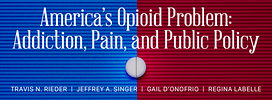Lead Essay
American pain medicine is desperately broken, says bioethicist Travis N. Rieder. To fix it, we must avoid swinging the pendulum too far toward over-medication—and too far toward under-medication. Either of these mistakes can drive patients toward the dangerous illicit opioid market. Instead, Rieder recommends harm reduction strategies, including safe injection sites and even prescriptions for pharmaceutical grade opioids to minimize the harms of addiction.
Response Essays
Jeffrey A. Singer agrees that pain is individualized and thus difficult to assess. The War on Drugs has made practicing medical pain management much more difficult, because doctors have grown averse to prescribing opioids, particularly in high doses. But it was not doctors prescribing too freely that prompted the recent crisis, and when doctors withdrew these medications, many patients turned to the streets.
Gail D’Onofrio says that clinicians have a good idea of what works in fighting opioid addiction and dependency. She calls for a multifaceted approach that involves medication, more treatment professionals, and ending the stigma of seeking treatment, which can often drive away people who would otherwise seek help. She outlines a variety of legislative and clinical practice reforms that she believes will help prevent and treat substance use disorders in the future.
“The chronic and relapsing nature of addiction—the very symptoms of addiction—are punished and criminalized,” writes Regina LaBelle, who argues that this punishment is counterproductive. The criminal justice system has become the default primary care provider for many and perhaps most addicts, and this situation helps no one in society, not even those who never use drugs at all.
Coming Up
Conversation to continue through the end of the month.
Related at Cato
Policy Analysis: “Harm Reduction: Shifting from a War on Drugs to a War on Drug-Related Deaths” by Jeffrey A. Singer, December 13, 2018
Policy Analysis: ”Overdosing on Regulation: How Government Caused the Opioid Epidemic” by Jeffrey Miron, February 14, 2019
Commentary: ”Opioid Industry Suits Are a Misguided Cash Grab Against Politically Unpopular Target” by Jeffrey Miron and Laura Nicolae, April 16, 2019
Testimony: ”Unintended Consequences: Medicaid and the Opioid Epidemic” by David A. Hyman

